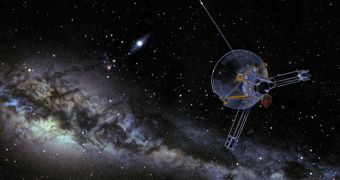Years ago, NASA mission controllers managing the Pioneer spacecraft detected a faint anomaly in the telemetry data the probes were relaying back to Earth. It appeared as if they were drifting slightly off course, although no clear reasons for these events were made obvious. A new study clears the mystery.
Investigators determined that heat is responsible for the drift. The Pioneer probes are now both located in the interstellar medium, but they can no longer be contacted via radio due to interferences.
Pioneer 10 was the first to launch, in 1972, with Pioneer 11 following suit in 1973. They are deep-space explorers and, as such, were put on a course that took them out of the solar system, and into the interstellar medium.
Their main mission was that fly further than the Inner Asteroid Belt – between the orbits of Mars and Jupiter – and to investigate the Jovian and Saturnine systems. They imaged both gas giants, some of their moons, and their impressive ring systems as they flew past.
At this point, it would appear that the Sun's gravity is forcing the probes to gradually slow down, despite the vast distance separating them from the star. This is a gold mine for researchers, who installed equipment that could detect gravitational pulls from the Sun outside the solar system.
The algorithm was developed by astronomer John Anderson, but the readings it predicted were different from what the spacecraft were sending back. This discrepancy was dubbed the Pioneer Anomaly, and experts have been trying to explain it for years.
The latest analysis indicate that heat generated by the radioactive plutonium fuel the probes are carrying may account for these differences. The entire mystery can be explained if heat generated by the thrusters is dissipated unevenly from the spacecraft.
If the heat is released in an uniform manner all around the probes, then the course would remain unaltered. However, if the front or back parts of the craft release just five percent more heat than the other, then the course would be slightly altered.
One of the most important pieces of evidence supporting this scenarios is the fact that the deceleration the spacecraft are experiencing appear to be decreasing at an exponential rate. This event was correlated to the natural radioactive decay of plutonium-238, Wired reports.
Other explanations may also be possible, but they appear less and less likely, experts say.

 14 DAY TRIAL //
14 DAY TRIAL //